Sir John Monash, Personal Files Book 14, 6 October - 30 November 1916, Part 1
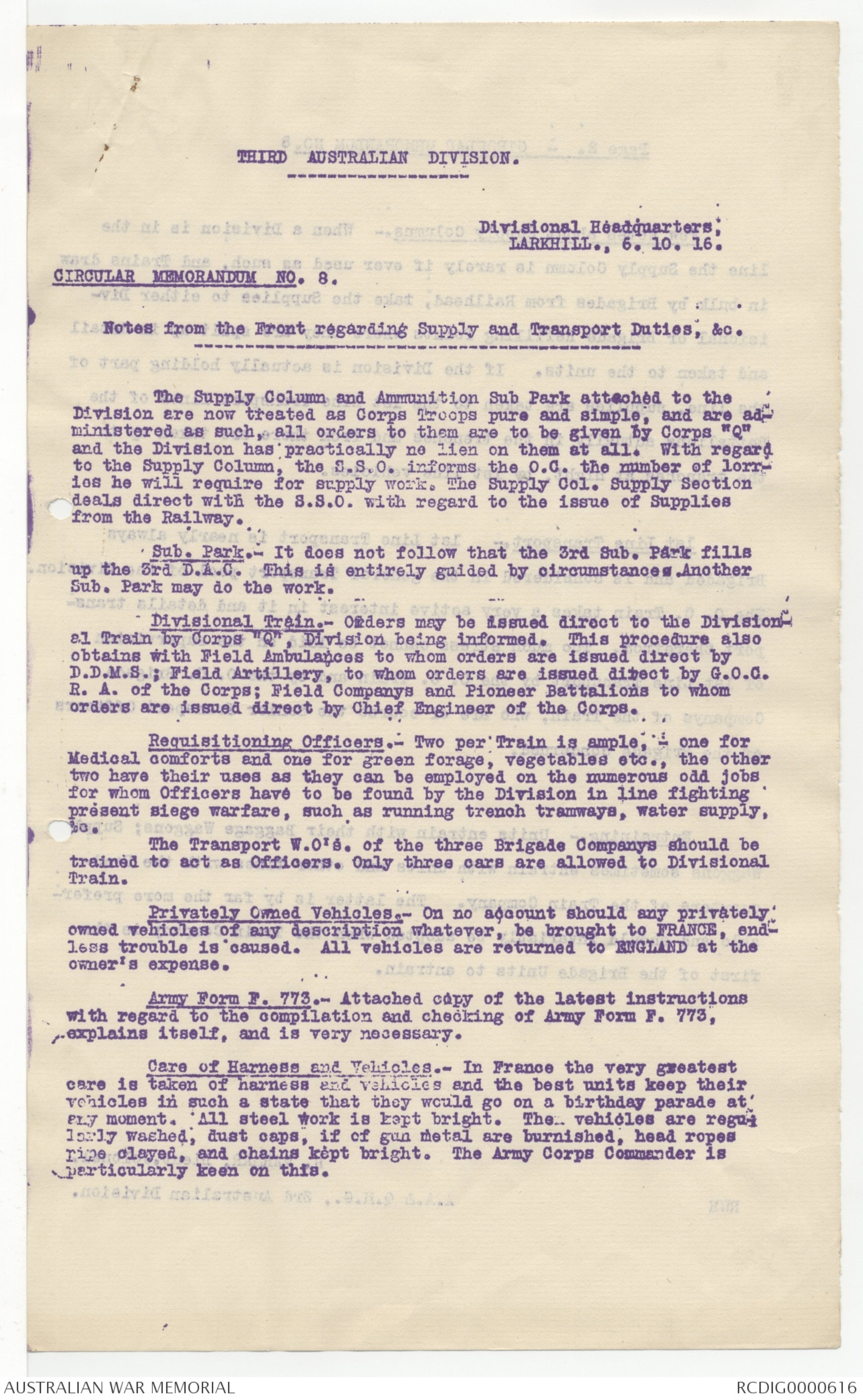
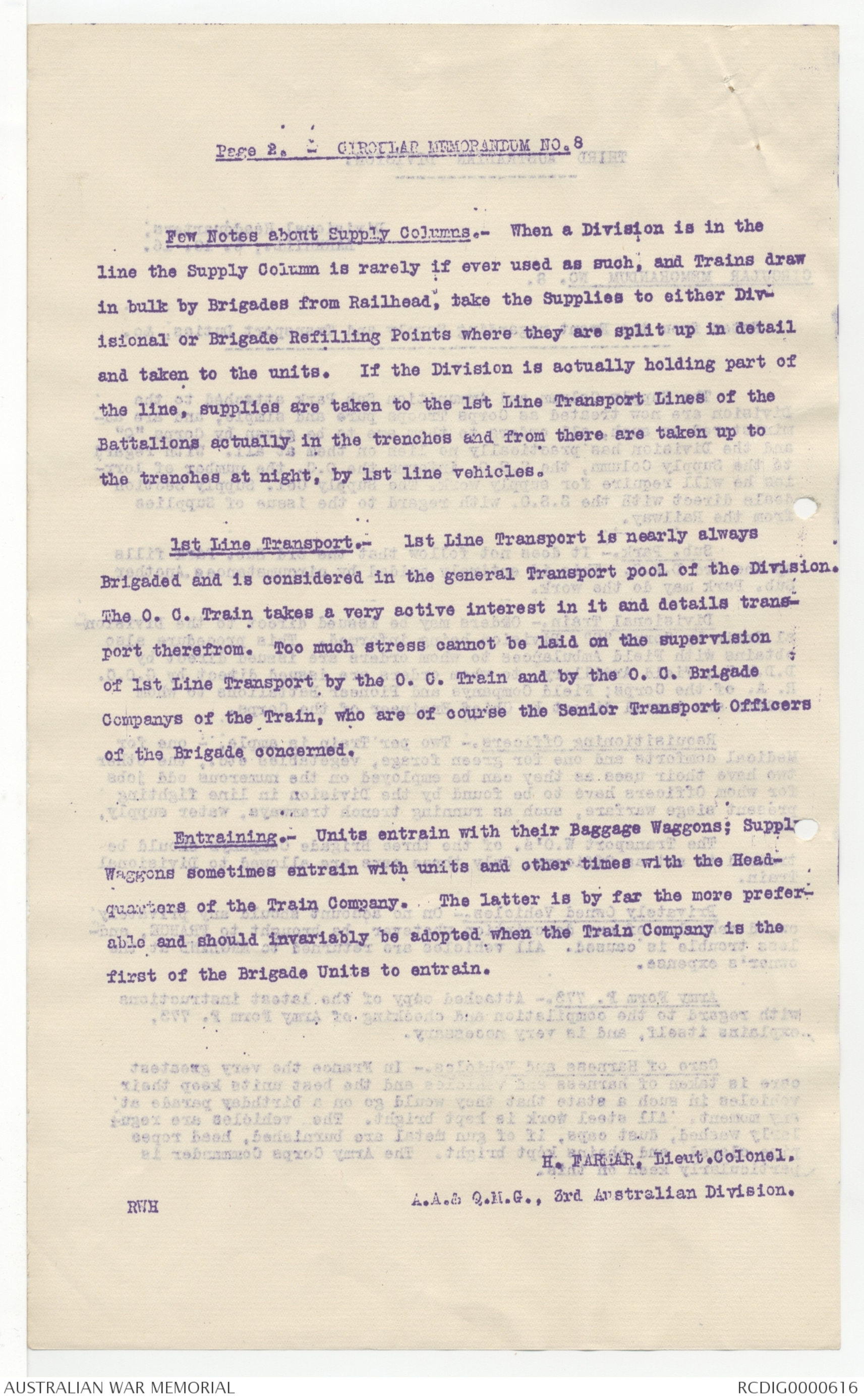

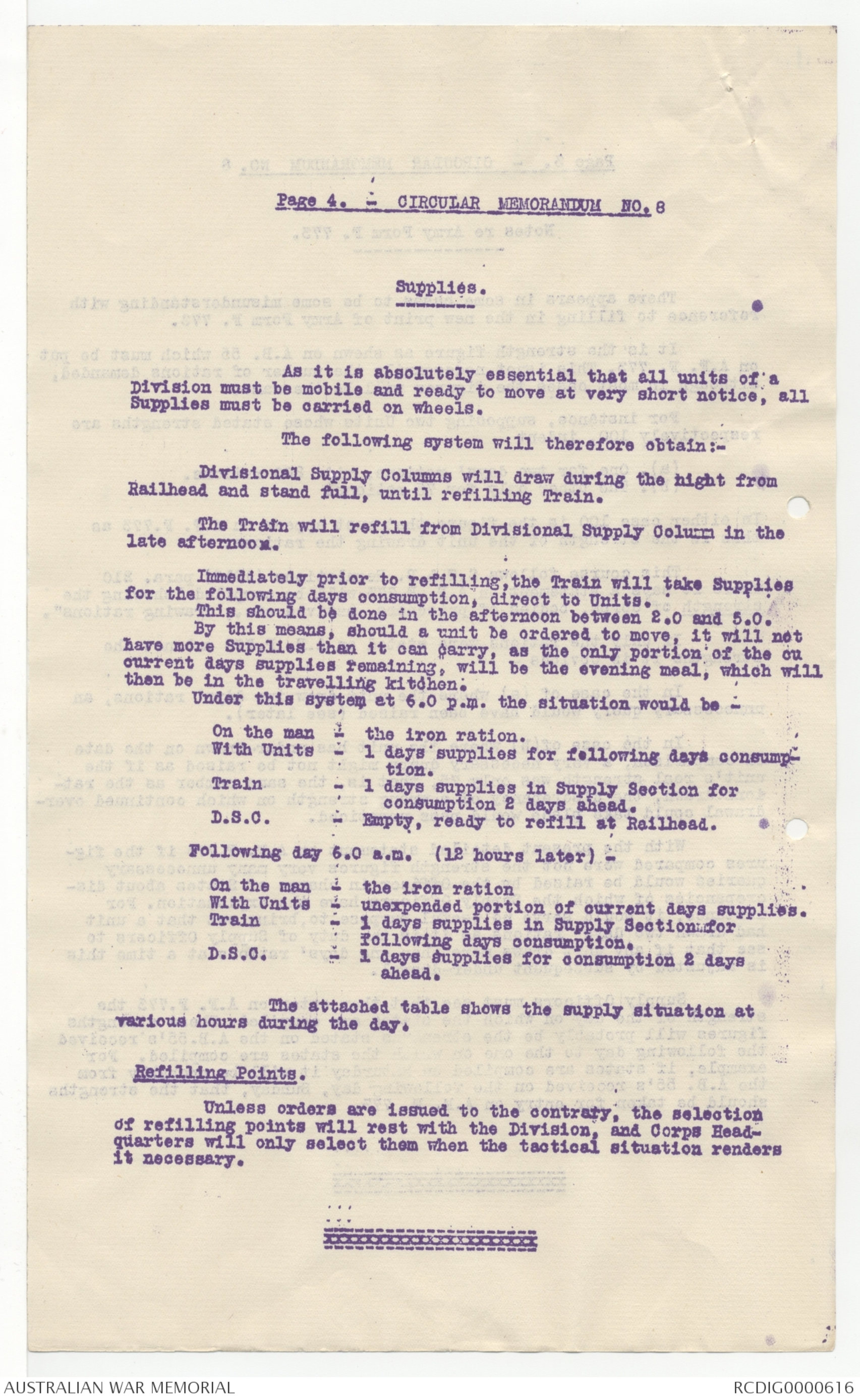
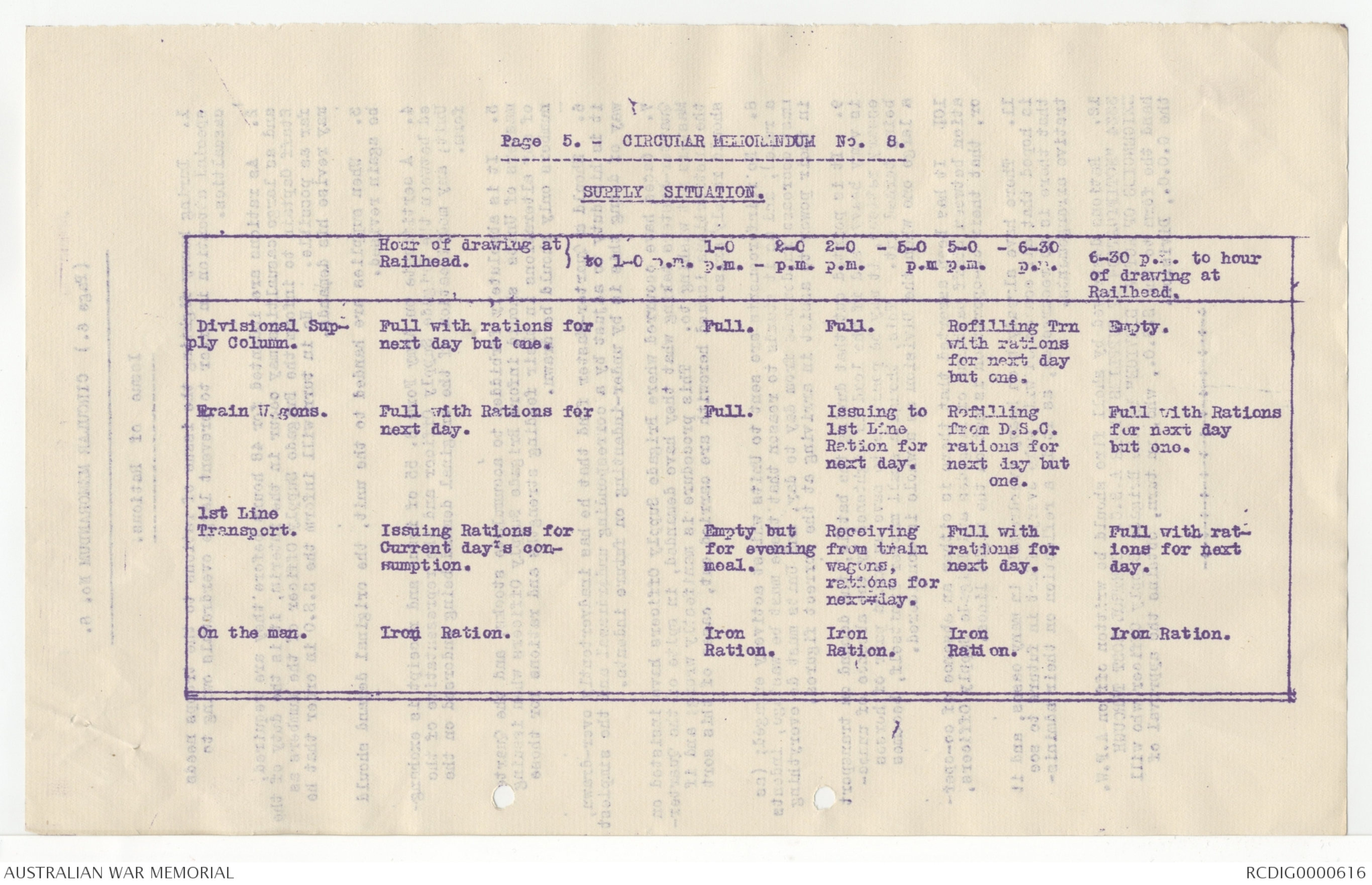
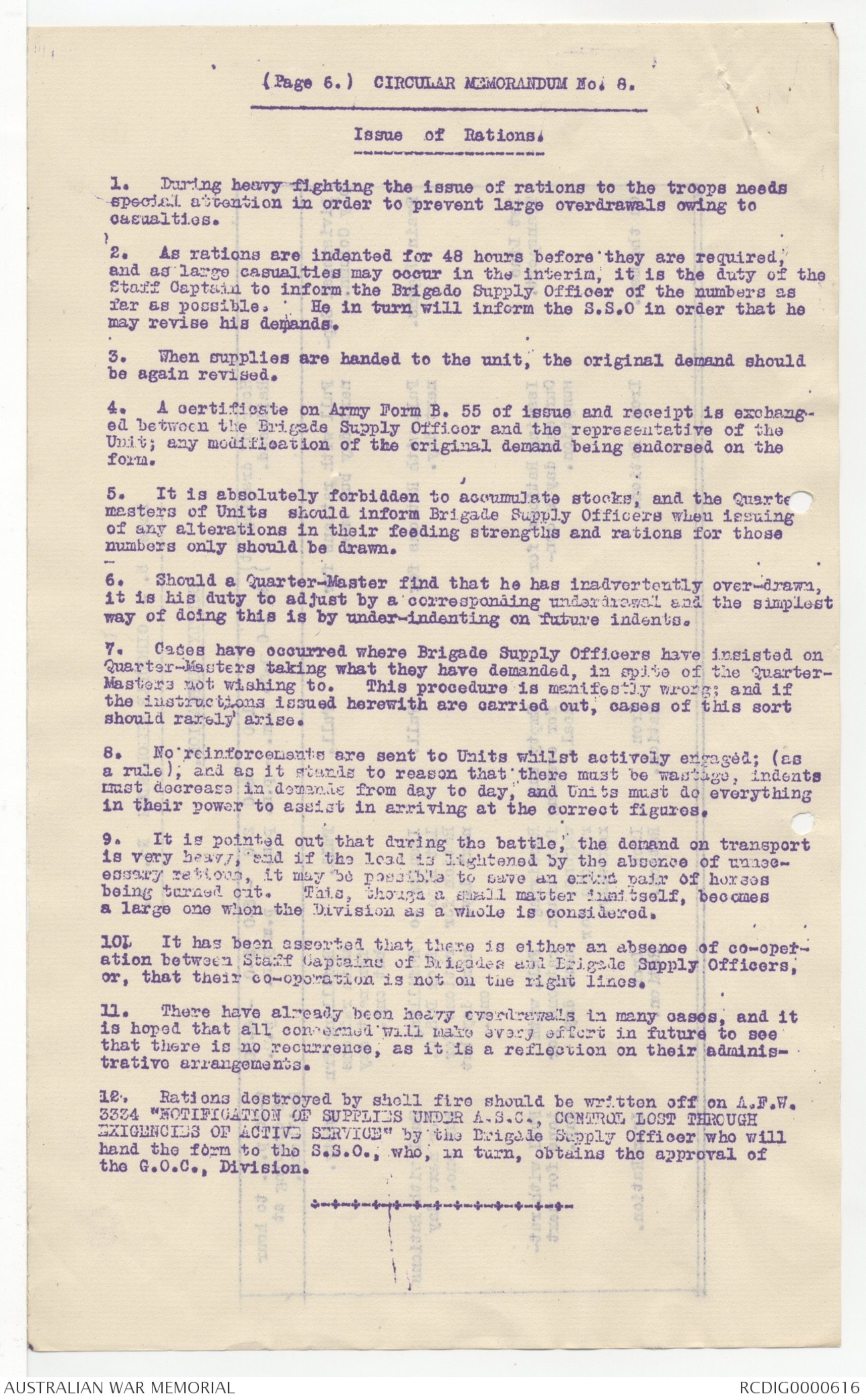
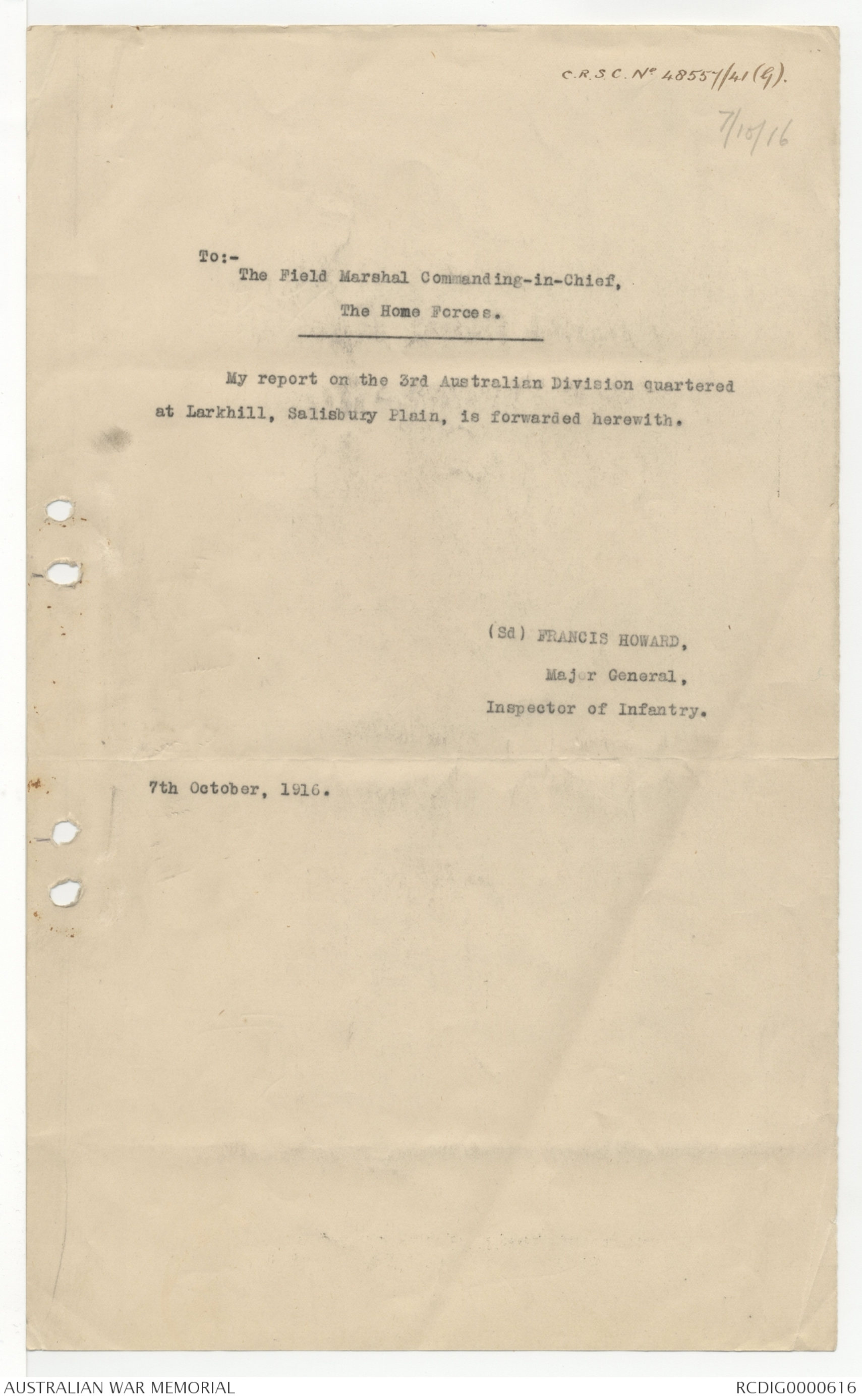
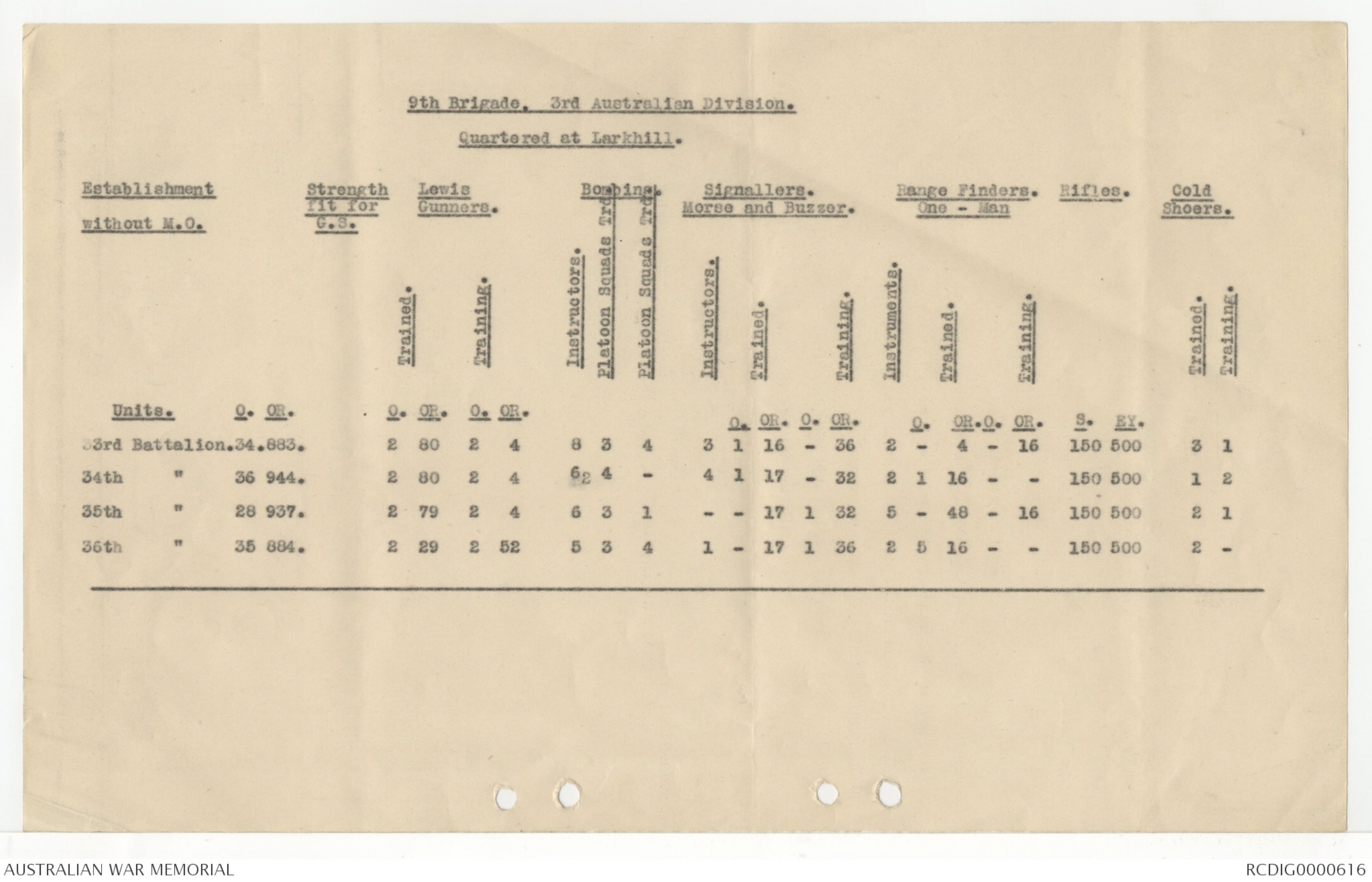
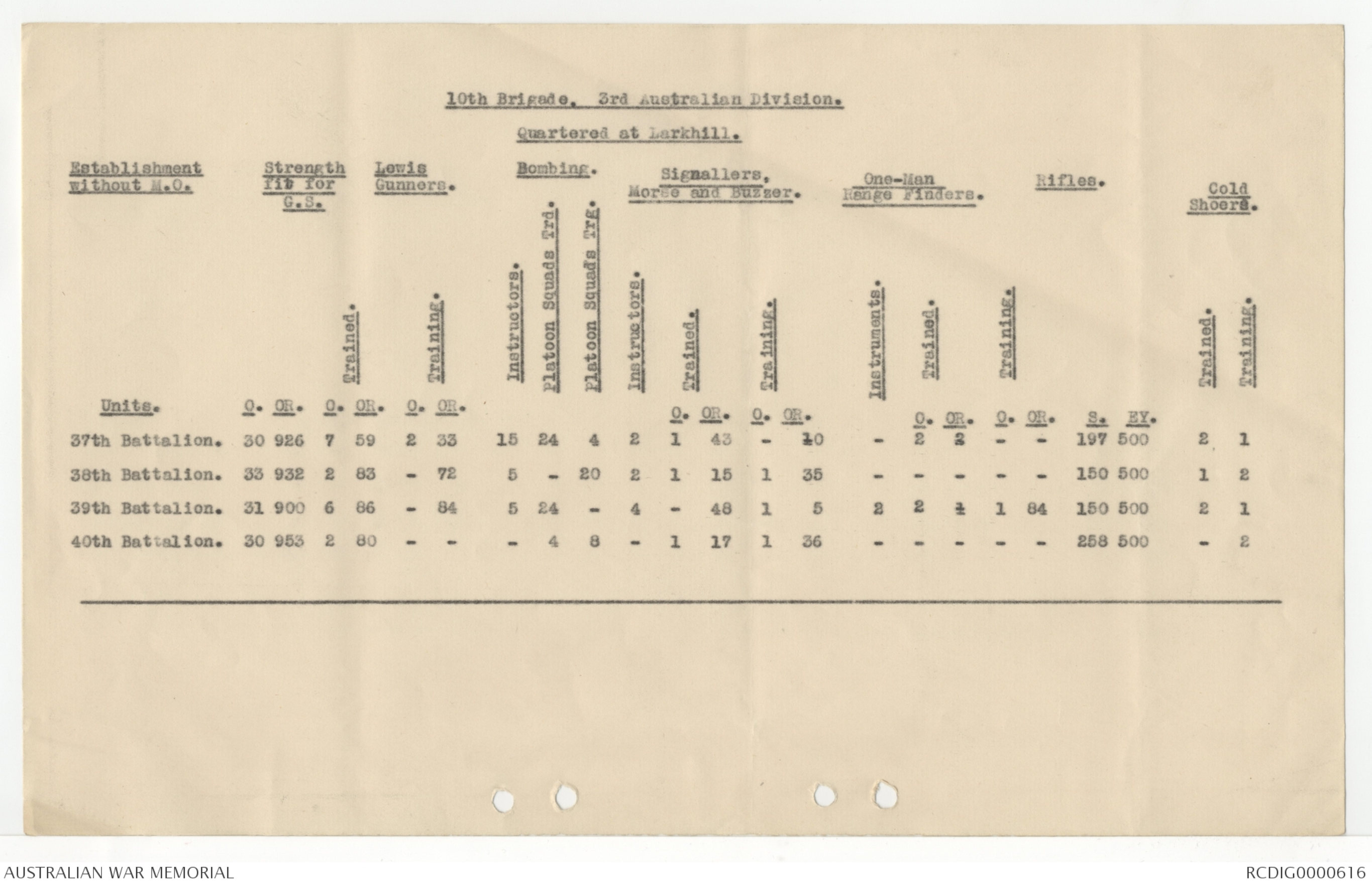
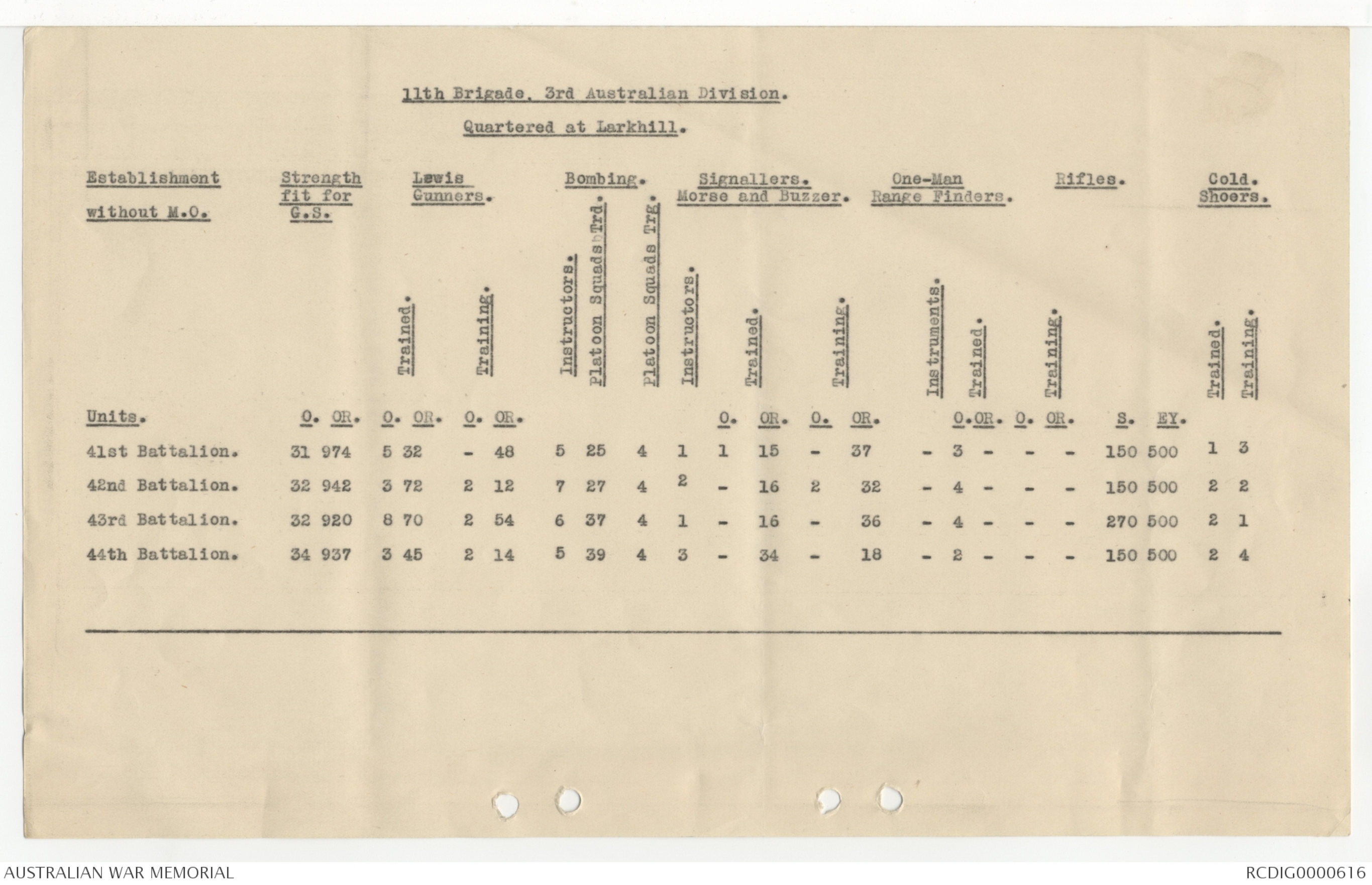
THIRD AUSTRALIAN DIVISION.
Divisional Headquarters,
LARKHILL., 6.10.16.
CIRCULAR MEMORANDUM NO. 8.
Notes from the Front regarding Supply and Transport Duties, &c.
The Supply Column and Ammunition Sub Park attached to the
Division are now treated as Corps Troops pure and simple, and are
administered as such, all orders to them are to be given by Corps "Q"
and the Division has practically no lien on them at all. With regard
to the Supply Column, the S.S.O. informs the O.C. the number of lorries
he will require for supply work. The Supply Col. Supply Section
deals direct with the S.S.O. with regard to the issue of Supplies
from the Railway.
Sub. Park. - It does not follow that the 3rd Sub. Park fills
up the 3rd D.A.C. This is entirely guided by circumstances. Another
Sub. Park may do the work.
Divisional Train. - Orders may be issued direct to the Divisional
Train by Corps "Q", Division being informed. This procedure also
obtains with Field Ambulances to whom orders are issued direct by
D.D.M.S.; Field Artillery, to whom orders are issued direct by G.O.C.
R.A. of the Corps: Field Companys and Pioneer Battalions to whom
orders are issued direct by Chief Engineer of the Corps.
Requisitioning Officers. - Two per Train is ample, - one for
the Medical comforts and one for green forage, vegetables etc., the other
two have their uses as they can be employed on the numerous odd jobs
for whom Officers have to be found by the Division in line fighting
present siege warfare, such as running trench tramways, water supply,
&c.
The Transport W.O's of the three Brigade Companys should be
trained to act as Officers. Only three cars are allowed to Divisional
Train.
Privately Owned Vehicles.- On no account should any privately
owned vehicles of any description whatever, be brought to FRANCE, endless
trouble is caused. All vehicles are returned to ENGLAND at the
owner's expense.
Army Form F. 773.- Attached copy of the latest instructions
with regard to the compilation and checking of Army Form
F. 773,
explains itself, and is very necessary.
Care of Harness and Vehicles.- In France the very greatest
care is taken of harness and vehicles and the best units keep their
vehicles in such a state that they would go on a birthday parade at
any moment. All steel work is kept bright. The vehicles are regularly
washed, dust caps, if of gun metal are burnished, head ropes
pipe clayed, and chains kept bright. The Army Corps Commander is
particularly keen on this.
Page 2. CIRCULAR MEMORANDUM NO. 8
Few Notes about Supply Columns.- When a Division is in the
line the Supply Column is rarely if ever used as such, and Trains draw
in bulk by Brigades from Railhead, take Supplies to either Divisional
or Brigade Refilling Points where they are split up in detail
and taken to the units. If the Division is actually holding part of
the line, supplies are taken to the 1st Line Transport Lines of the
Battalions actually in the trenches and from there are taken up to
the trenches at night, by 1st line vehicles.
1st line Transport.- 1st Line Transport is nearly always
Brigaded and is considered in the general Transport pool of the Division.
The O.C. Train takes a very active interest in it and details transport
therefrom. Too much stress cannot be laid on the supervision
of 1st Line Transport by the O. C. Train and by the O. C. Brigade
Companys of the Train, who are of course the Senior Transport Officers
of the Brigade concerned.
Entraining.- Units entrain with their Baggage Waggons; Supply
Waggons sometimes entrain with units and other times with the
Headquarters of the Train Company. The latter is by far the more
preferable and should invariably be adopted when the Train Company is the
first of the Brigade Units to entrain.
H. FARRAR, Lieut. Colonel.
A.A. & Q.M.G., 3rd Australian Division.
RWH
Page 3. - CIRCULAR MEMORANDUM NO. 8
Notes re Army Form F. 773
There appears in some cases to be some misunderstanding with
reference to filling in the new print of Army Form F. 773.
It is the strength figure as shewn on A.B. 55 which must be put
on A.F. F.773. This is not necessarily the number of rations demanded,
although in most cases the figures will be the same
For instance, supposing two Units whose stated strengths are
respectively 100, indent
(a). One for two days' rations, viz: 200 rations.
(b). The other only for 75 rations
In either case 100 is the figure that must appear on A.F. F.773
as this is the strength of the unit drawing the rations.
This course follows S. T. & B. Regulations (1915) para. 210
where it says a statement on A.F. F.773 will be compiled "showing the
strength of corps, bodies of prisoners, natives etc., drawing rations"
If only the rations were stated on A.F. F.773 and not the
strengths it is obvious -
In the case of (a) where the unit drew two days' rations, an
unnecessary query would have been raised (see later).
In the case of (b) where the unit has under-drawn on the date
of comparison, a very necessary query might not be raised as if the
unit's real strength was only 75, that is, the same number as the rations
drawn, the discrepancy of a wrong strength on which continued over-drawal
could take place would pass unnoticed.
With the present detailed statement on A.F. F.773 if the figures
compared were not the strength figures very many unnecessary
queries would be raised by the Officer in charge of States about
discrepancies of which the Supply Officers have the explanation. For
instance, it would serve no useful purpose to, bring out that a unit
had drawn two days' rations as it is the duty of Supply Officers to
see that if any unit draws more than one days' rations at a time this
is adjusted by subsequent under-drawal.
Supply Officers must see that they enter of A.F. F.773 the
strength of the day on which the states are compiled. These strengths
figures will probably be the strengths stated on the A.B.55's received
the following day to the one on which the states are compiled. For
example, if states are compiled on Saturday it will be probably from
the A.B. 55's received on the following day, Sunday, that the strengths
should be taken for entry on A.F. F.773.
Page 4. - CIRCULAR MEMORANDUM NO. 8
Supplies
As it is absolutely essential that all unites of a
Division must be mobile and ready to move at very short notice, all
Supplies must be carried on wheels.
The following system will therefore obtain:-
Divisional Supply Columns will draw during the night from
Railhead and stand full, until refilling Train.
The Train will refill from Divisional Supply Column in the
late afternoon.
Immediately prior to refilling, the Train will take Supplies
for the following days consumption, direct to Units.
This should be done in the afternoon between 2.0 and 5.0.
By this means, should a unit be ordered to move, it will not
have more Supplies than it can carry, as the only portion of the cu
current days supplies remaining will be the evening meal, which will
then be in the travelling kitchen.,
Under this system at 6.0 p.m. the situation would be -
On the man - the iron ration.
With Units - 1 days supplies for the following days consumption.
Train - 1 days supplies in Supply Section for
consumption 2 days ahead.
D.S.C. - Empty, ready to refill at Railhead.
Following day 6.0 a.m. (12 hours later) -
On the man - the iron ration
With Units - unexpended portion of current days supplies.
Train - 1 days supplies in Supply Section for
following days consumption.
D.S.C. - 1 days supplies for consumption 2 days
ahead.
The attached table shows the supply situation at
various hours during the day.
Refilling Points.
Unless orders are issued to the contrary, the selection
of refilling points will rest with the Division, and Corps Headquarters
will only select them when the tactical situation renders
it necessary.
Page 5. - CIRCULAR MEMORANDUM No. 8.
SUPPLY SITUATION.
|
Hour of drawing at Railhead} to-1.0p.m.
|
1.0 p.m. |
-2.0 p.m |
2.0 p.m. |
-5.0 p.m. |
5.0 p.m. |
-6.30 p.m. |
6.30 p.m. to hour of drawing at Railhead. | |
| Divisional Supply Column. |
Full with rations for next day but one. |
Full. |
Full. |
Refilling Trn with rations for next day but one. | Empty. | |||
| Train W gons. |
Full with Rations for next day. |
Full. |
Issuing to 1st Line Ration for next day. |
Refilling from D.S.C. rations for next day but one. | Full with Rations for next day but one. |
|||
| 1st Line Transport. |
Issuing Rations for Current day's consumption. |
Empty but for evening meal. |
Receiving from train wagons, rations for next day. | Full with rations for next day. |
Full with rations for next day. | |||
| On the man. | Iron Ration. |
Iron Ration. | Iron Ration. | Iron Ration. | Iron Ration. | |||
(Page 6.) CIRCULAR MEMORANDUM No. 8.
Issue of Rations.
1. During heavy fighting the issue of rations to the troops needs
special attention in order to prevent large overdrawals owing to
casualties.
2. As rations are indented for 48 hours before they are required,
and as large casualties may occur in the interim, it is the duty of the
Staff Captain to inform the Brigade Supply Officer of the numbers as
far as possible. He in turn will inform the S.S.O in order that he
may revise his demands.
3. When supplies are handed to the unit, the original demand should
be again revised.
4. A certificate on Army Form B. 55 of issue and receipt is exchanged
between the Brigade Supply Officer and the representative of the
Unit; any modification of the original demand being endorsed on the
form.
5. It is absolutely forbidden to accumulate stocks, and the Quartermasters
of Units should inform Brigade Supply Officers when issuing
of any alterations in their feeding strengths and rations for those
numbers only should be drawn.
6. Should a Quarter-Master find that he has inadvertently over-drawn,
it is his duty to adjust by a corresponding underdrawal and the simplest
way of doing this is by under-indenting on future indents.
7. Cases have occurred where Brigade Supply Officers have insisted on
Quarter-Masters taking what they have demanded, in spite of the
Quarter-Masters not wishing to. This procedure is manifestly wrong; and if
the instructions issued herewith are carried out, cases of this sort
should rarely arise.
8. No reinforcements are sent to Units whilst actively engaged; (as
a rule); and so it stands to reason that there must be wastage, indents
must decrease in demands from day to day, and Units must do everything
in their power to assist in arriving at the correct figures.
9. It is pointed out that during the battle, the demand on transport
is very heavy, and if the load is lightened by the absence of unnecessary
rations, it may be possible to save an extra pair of horses
being turned out. This, though a small matter in itself, becomes
a large one when the Division as a whole is considered.
10.L It has been asserted that there is either an absence of
co-operation
between Staff Captains of Brigades and Brigade Supply Officers,
or, that their co-operation is not on the right lines.
11. There have already been heavy overdrawals in many cases, and it
is hoped that all concerned will make every effort in future to see
that there is no recurrence, as it is a reflection on their administrative
arrangements.
12. Rations destroyed by shell fire should be written off on A.F.W.
3334 "NOTIFICATION OF SUPPLIES UNDER A.S.C., CONTROL LOST THROUGH
EXIGENCIES OF ACTIVE SERVICE" by the Brigade Supply Officer who will
hand the form to the S.S.O., who, in turn, obtains the approval of
the G.O.C., Division.
C.R.S.C. No. 48557/41(G).
7/15/16
To:-
The Field Marshal Commanding-in Chief,
The Home Forces.
My report on the 3rd Australian Division quartered
at Larkhill, Salisbury Plain, is forwarded herewith.
(Sd) FRANCIS HOWARD,
Maajor General,
Inspector of Infantry.
7th October, 1916.
9th Brigade. 3rd Australian Division.
Quartered at Larkhill.
Transcriber's note: the tables below are one large table in original. They have been split to suit formatting. Unit column repeated in second table for clarity.
| Establishment without M.O. |
Strength fit for G.S. | Lewis Gunners. |
Bombing. |
||||||
| Trained. |
Training. |
Instructors. |
Platoon Squads Trd. | Platoon Squads Trg. | |||||
| Units. | O. | OR. | O. | OR. | O. | OR. | |||
| 33rd Battalion | 34. | 883. | 2 | 80 | 2 | 4 |
8 |
3 |
4 |
| 34th " | 36 | 944. | 2 | 80 | 2 | 4 |
62 |
4 |
- |
| 35th " | 28 | 937. | 2 | 79 | 2 | 4 |
6 |
3 |
1 |
| 36th " | 35 | 884. | 2 | 29 | 2 | 52 |
5 |
3 |
4 |
|
Signallers. |
Range Finders. |
Rifles. |
Cold |
|||||||||||
| Instructors. | Trained. | Training. | Instruments. | Trained. | Training. | Trained. | Training. | |||||||
| Units. | O. | OR. | O. | OR. | O. | OR. | O. | OR. | S. | EY. | ||||
| 33rd Battalion |
3 |
1 | 16 | - | 36 |
2 |
- | 4 | - | 16 | 150 | 500 |
3 |
1 |
| 34th " |
4 |
1 | 17 | - | 32 |
2 |
1 | 16 | - | - | 150 | 500 |
1 |
2 |
| 35th " |
- |
- | 17 | 1 | 32 |
5 |
- | 48 | - | 16 | 150 | 500 |
2 |
1 |
| 36th " |
1 |
- | 17 | 1 | 36 |
2 |
5 | 16 | - | - | 150 | 500 |
2 |
- |
10th Brigade. 3rd Australian Division.
Quartered at Larkhill.
Transcriber's note: the tables below are one large table in original. They have been split to suit formatting. Unit column repeated in second table for clarity.
| Establishment without M.O. |
Strength fit for G.S. | Lewis Gunners. |
Bombing. |
||||||
| Trained. |
Training. |
Instructors. |
Platoon Squads Trd. | Platoon Squads Trg. | |||||
| Units. | O. | OR. | O. | OR. | O. | OR. | |||
| 37th Battalion. | 30 | 926 | 7 | 59 | 2 | 33 |
15 |
24 |
4 |
| 38th Battalion. | 33 | 932 | 2 | 83 | - | 72 |
5 |
- |
20 |
| 39th Battalion. | 31 | 900 | 6 | 86 | - | 84 |
5 |
24 |
- |
| 40th Battalion. | 30 | 953 | 2 | 80 | - | - |
- |
4 |
8 |
|
Signallers. |
One - Man |
Rifles. |
Cold |
|||||||||||
| Instructors. | Trained. | Training. | Instruments. | Trained. | Training. | Trained. | Training. | |||||||
| Units. | O. | OR. | O. | OR. | O. | OR. | O. | OR. | S. | EY. | ||||
| 37th Battalion |
2 |
1 | 43 | - | 10 |
- |
2 | 2 | - | - | 197 | 500 |
2 |
1 |
| 38th " |
2 |
1 | 15 | 1 | 35 |
- |
- | - | - | - | 150 | 500 |
1 |
2 |
| 39th " |
4 |
- | 48 | 1 | 5 |
2 |
2 | 1 | 84 | 150 | 500 |
2 |
1 |
|
| 40th " |
- |
1 | 17 | 1 | 36 |
- |
- | - | - | - | 258 | 500 |
- |
2 |
11th Brigade. 3rd Australian Division.
Quartered at Larkhill.
Transcriber's note: the tables below are one large table in original. They have been split to suit formatting. Unit column repeated in second table for clarity.
| Establishment without M.O. |
Strength fit for G.S. | Lewis Gunners. |
Bombing. |
||||||
| Trained. |
Training. |
Instructors. |
Platoon Squads Trd. | Platoon Squads Trg. | |||||
| Units. | O. | OR. | O. | OR. | O. | OR. | |||
| 41st Battalion. | 31 | 974 | 5 | 32 | - | 48 |
5 |
25 |
4 |
| 42nd Battalion. | 32 | 942 | 3 | 72 | 2 | 12 |
7 |
27 |
4 |
| 43rd Battalion. | 32 | 920 | 8 | 70 | 2 | 54 |
6 |
37 |
4 |
| 44th Battalion. | 34 | 937 | 3 | 45 | 2 | 14 |
5 |
39 |
4 |
|
Signallers. |
One - Man |
Rifles. |
Cold |
|||||||||||
| Instructors. | Trained. | Training. | Instruments. | Trained. | Training. | Trained. | Training. | |||||||
| Units. | O. | OR. | O. | OR. | O. | OR. | O. | OR. | S. | EY. | ||||
| 41st Battalion |
1 |
1 | 15 | - | 37 |
- |
3 | - | - | - | 150 | 500 |
1 |
3 |
| 42nd " |
2 |
- | 16 | 2 | 32 |
- |
4 | - | - | - | 150 | 500 |
2 |
2 |
| 43rd " |
1 |
- | 16 | - | 36 |
- |
4 | - | - | - | 270 | 500 |
2 |
1 |
| 44th " |
3 |
- | 34 | = | 18 |
- |
2 | - | - | - | 150 | 500 |
2 |
4 |
 Sam scott
Sam scottThis transcription item is now locked to you for editing. To release the lock either Save your changes or Cancel.
This lock will be automatically released after 60 minutes of inactivity.